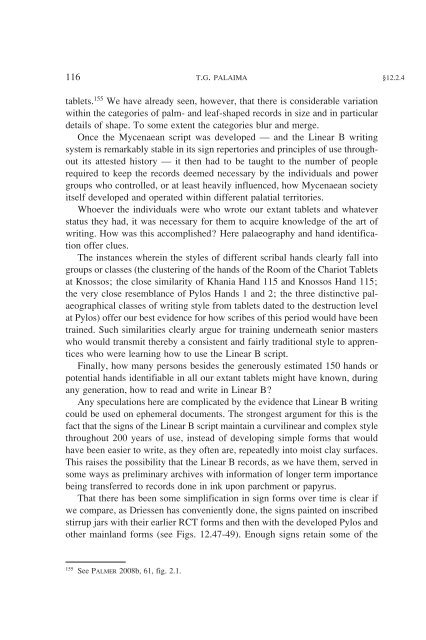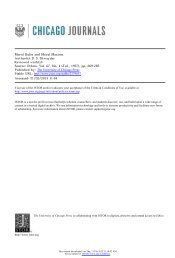A Companion to Linear B - The University of Texas at Austin
A Companion to Linear B - The University of Texas at Austin
A Companion to Linear B - The University of Texas at Austin
You also want an ePaper? Increase the reach of your titles
YUMPU automatically turns print PDFs into web optimized ePapers that Google loves.
116 T.G. PALAIMA §12.2.4<br />
tablets. 155 We have already seen, however, th<strong>at</strong> there is considerable vari<strong>at</strong>ion<br />
within the c<strong>at</strong>egories <strong>of</strong> palm- and leaf-shaped records in size and in particular<br />
details <strong>of</strong> shape. To some extent the c<strong>at</strong>egories blur and merge.<br />
Once the Mycenaean script was developed — and the <strong>Linear</strong> B writing<br />
system is remarkably stable in its sign reper<strong>to</strong>ries and principles <strong>of</strong> use throughout<br />
its <strong>at</strong>tested his<strong>to</strong>ry — it then had <strong>to</strong> be taught <strong>to</strong> the number <strong>of</strong> people<br />
required <strong>to</strong> keep the records deemed necessary by the individuals and power<br />
groups who controlled, or <strong>at</strong> least heavily influenced, how Mycenaean society<br />
itself developed and oper<strong>at</strong>ed within different pal<strong>at</strong>ial terri<strong>to</strong>ries.<br />
Whoever the individuals were who wrote our extant tablets and wh<strong>at</strong>ever<br />
st<strong>at</strong>us they had, it was necessary for them <strong>to</strong> acquire knowledge <strong>of</strong> the art <strong>of</strong><br />
writing. How was this accomplished? Here palaeography and hand identific<strong>at</strong>ion<br />
<strong>of</strong>fer clues.<br />
<strong>The</strong> instances wherein the styles <strong>of</strong> different scribal hands clearly fall in<strong>to</strong><br />
groups or classes (the clustering <strong>of</strong> the hands <strong>of</strong> the Room <strong>of</strong> the Chariot Tablets<br />
<strong>at</strong> Knossos; the close similarity <strong>of</strong> Khania Hand 115 and Knossos Hand 115;<br />
the very close resemblance <strong>of</strong> Pylos Hands 1 and 2; the three distinctive palaeographical<br />
classes <strong>of</strong> writing style from tablets d<strong>at</strong>ed <strong>to</strong> the destruction level<br />
<strong>at</strong> Pylos) <strong>of</strong>fer our best evidence for how scribes <strong>of</strong> this period would have been<br />
trained. Such similarities clearly argue for training underne<strong>at</strong>h senior masters<br />
who would transmit thereby a consistent and fairly traditional style <strong>to</strong> apprentices<br />
who were learning how <strong>to</strong> use the <strong>Linear</strong> B script.<br />
Finally, how many persons besides the generously estim<strong>at</strong>ed 150 hands or<br />
potential hands identifiable in all our extant tablets might have known, during<br />
any gener<strong>at</strong>ion, how <strong>to</strong> read and write in <strong>Linear</strong> B?<br />
Any specul<strong>at</strong>ions here are complic<strong>at</strong>ed by the evidence th<strong>at</strong> <strong>Linear</strong> B writing<br />
could be used on ephemeral documents. <strong>The</strong> strongest argument for this is the<br />
fact th<strong>at</strong> the signs <strong>of</strong> the <strong>Linear</strong> B script maintain a curvilinear and complex style<br />
throughout 200 years <strong>of</strong> use, instead <strong>of</strong> developing simple forms th<strong>at</strong> would<br />
have been easier <strong>to</strong> write, as they <strong>of</strong>ten are, repe<strong>at</strong>edly in<strong>to</strong> moist clay surfaces.<br />
This raises the possibility th<strong>at</strong> the <strong>Linear</strong> B records, as we have them, served in<br />
some ways as preliminary archives with inform<strong>at</strong>ion <strong>of</strong> longer term importance<br />
being transferred <strong>to</strong> records done in ink upon parchment or papyrus.<br />
Th<strong>at</strong> there has been some simplific<strong>at</strong>ion in sign forms over time is clear if<br />
we compare, as Driessen has conveniently done, the signs painted on inscribed<br />
stirrup jars with their earlier RCT forms and then with the developed Pylos and<br />
other mainland forms (see Figs. 12.47-49). Enough signs retain some <strong>of</strong> the<br />
155 See PALMER 2008b, 61, fig. 2.1.

















